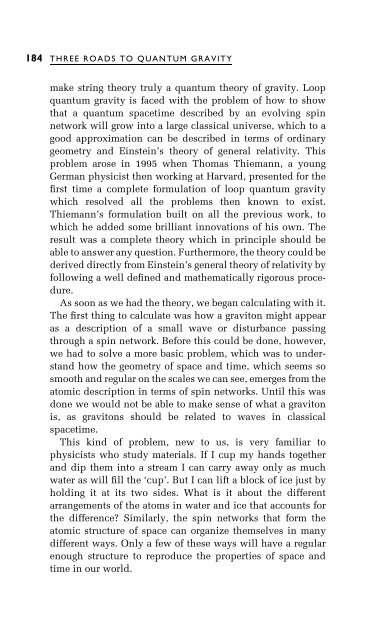Three Roads To Quantum Gravity
Three Roads To Quantum Gravity
Three Roads To Quantum Gravity
Create successful ePaper yourself
Turn your PDF publications into a flip-book with our unique Google optimized e-Paper software.
184 THREE ROADS TO QUANTUM GRAVITY<br />
make string theory truly a quantum theory of gravity. Loop<br />
quantum gravity is faced with the problem of how to show<br />
that a quantum spacetime described by an evolving spin<br />
network will grow into a large classical universe, which to a<br />
good approximation can be described in terms of ordinary<br />
geometry and Einstein's theory of general relativity. This<br />
problem arose in 1995 when Thomas Thiemann, a young<br />
German physicist then working at Harvard, presented for the<br />
®rst time a complete formulation of loop quantum gravity<br />
which resolved all the problems then known to exist.<br />
Thiemann's formulation built on all the previous work, to<br />
which he added some brilliant innovations of his own. The<br />
result was a complete theory which in principle should be<br />
able to answer any question. Furthermore, the theory could be<br />
derived directly from Einstein's general theory of relativity by<br />
following a well de®ned and mathematically rigorous procedure.<br />
As soon as we had the theory, we began calculating with it.<br />
The ®rst thing to calculate was how a graviton might appear<br />
as a description of a small wave or disturbance passing<br />
through a spin network. Before this could be done, however,<br />
we had to solve a more basic problem, which was to understand<br />
how the geometry of space and time, which seems so<br />
smooth and regular on the scales we can see, emerges from the<br />
atomic description in terms of spin networks. Until this was<br />
done we would not be able to make sense of what a graviton<br />
is, as gravitons should be related to waves in classical<br />
spacetime.<br />
This kind of problem, new to us, is very familiar to<br />
physicists who study materials. If I cup my hands together<br />
and dip them into a stream I can carry away only as much<br />
water as will ®ll the `cup'. But I can lift a block of ice just by<br />
holding it at its two sides. What is it about the different<br />
arrangements of the atoms in water and ice that accounts for<br />
the difference? Similarly, the spin networks that form the<br />
atomic structure of space can organize themselves in many<br />
different ways. Only a few of these ways will have a regular<br />
enough structure to reproduce the properties of space and<br />
time in our world.



![arXiv:1001.0993v1 [hep-ph] 6 Jan 2010](https://img.yumpu.com/51282177/1/190x245/arxiv10010993v1-hep-ph-6-jan-2010.jpg?quality=85)


![arXiv:1008.3907v2 [astro-ph.CO] 1 Nov 2011](https://img.yumpu.com/48909562/1/190x245/arxiv10083907v2-astro-phco-1-nov-2011.jpg?quality=85)








![arXiv:1002.4928v1 [gr-qc] 26 Feb 2010](https://img.yumpu.com/41209516/1/190x245/arxiv10024928v1-gr-qc-26-feb-2010.jpg?quality=85)
![arXiv:1206.2653v1 [astro-ph.CO] 12 Jun 2012](https://img.yumpu.com/39510078/1/190x245/arxiv12062653v1-astro-phco-12-jun-2012.jpg?quality=85)
